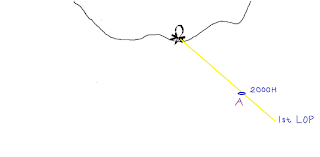How to make a running fix position in chartwork?
Running fix is normally used when vessel is navigating along the coast where only one fix object is available to the mariner to stablish a fix position. In order to get a fix position using a running fix method, the following steps can be use.
1st, take the bearing of a fix/charted object on the shore to make a position line. Note the time you took the bearing of the object. From the position line, take a suitable point anywhere on the position line and mark this as A. Assume that your vessel might be anywhere on this line.
From the selected point (A), draw your course line and calculate the distance travelled in a given minutes of interval between the 1st sight and 2nd sight of the target. In this case for example, our vessel is on course 260°T travelling at speed of 20knots. The distance she will cover in 30mins of interval was 10miles. This can be calculated by distance= speed × time.
After applying the distance covered in 30mins together with the course of the vessel, we can apply the current which can greatly affect the course and speed of the vessel. In this case the current is setting on 300°T at a rate of 2knots. We can calculate the drift made by the current by using the formula (Dist=Spd of current × time interval). After applying the current effect, we need to make a parallel line from the 1st position line and connect it to the end of line of the current and course made good as shown in the drawings.
Draw the 2nd position line by taking the 2nd bearing of the charted object. The intersection of the 2nd position line and the line which is parallel to the 1st position line is the actual position at 2030h which was indicated as point B. Mark this position and note the time.
In order to find our position at 2000h , make a line parallel to our course made good and connect it to our 2nd position at 2030h. The point where the transfered line intersec the 1st position line is our actual position at 2000h.






Comments
Post a Comment